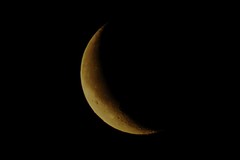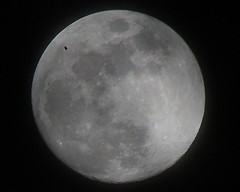Shooting pictures of the moon is surprisingly easy, but can still be frustrating at times.
You will need a lens with a really good focal length. For my pictures of the moon I use a 70-300 zoom at 300mm and then add a 2x tele-converter on it. The tele-converter does reduce my light by about 2 stops, but since the visible portion of the moon is lit by the sun the amount of light you are receiving is actually a lot. I set the f-stop to f/8, the ISO at 200 and zoom in as close as I can get with my lens which is approximately a 600mm focal length. This results in the moon taking up about 25-33% of my image. Depending on the amount of light the exposure times vary from 1/10th of a second up to 5 seconds. I don't recommend shooting the moon for over 2 seconds though because of the movement in both the earth and the moon. shot a couple of test shots and see what time works best.
Also you will want to set your camera to manual focus if possible. Most cameras have a hard time focusing with low light. This also the reason to have a high zoom lens so you can actually tell that you pictures are in focus.
If your camera has it, use you mirror lock up setting. This will help prevent movement of your camera when it actually snaps the picture. Another item that will help reduce camera shake is a remote shutter release.
You will also need a very sturdy tripod to work with. I recommend a tripod as opposed to other means of steadying you camera for several reasons. #1 is a tripod is easier to pan and tilt than a bean bag or other fixed object. The moon moves in a surprisingly short amount of time and it is a pain in the derriere to constantly be moving a bean bag around. #2 is a tripod leaves your hands free to do anything else you need to do and you don't have to worry about someone knocking your camera around when you turn your back. When using your tripod do not forget to take any anti-shake controls off. If you leave them on you risk having the camera think it needs to stabilize the image when it doesn't need to.
Other items that are useful to have when you are out at night are:
Flashlight (preferably a red light one)-my camera does not have the option of having a backlight to see the camera settings by and it is a pain to have to look through the eyepiece every time I want to change my shutter speed.
Appropriate clothing for the weather-you may think this means bringing a jacket during the cold months, but even during the summer the nights can get rather chilly. Gloves are also a very good idea because if your hands don't work because of the cold you won't be able to operate your camera efficiently.
Snacks & drinks-if you are planning to be out for a long period of time you will want to bring something to snack on and maybe a thermos of your favorite beverage.
Cell phone-Just in case something happens (car breaks down, bear attack, etc.). Also, whether you own a cell phone or not it is always a good idea to let someone know where you are going and what time you are planning on getting back. always expect the unexpected.
All the kit you need to keep your camera going (batteries, spare film/memory cards, etc.)-you don't have to bring your entire kit with you, but it really sucks if you're getting some great photos and your batteries run out. Before you go out make sure all of your batteries are charged.
Hopefully soon I will be able to get a decent 500mm lens that I will use with my tele-converter and get some really close pictures of the moon's surface.
Subscribe to:
Post Comments (Atom)




No comments:
Post a Comment